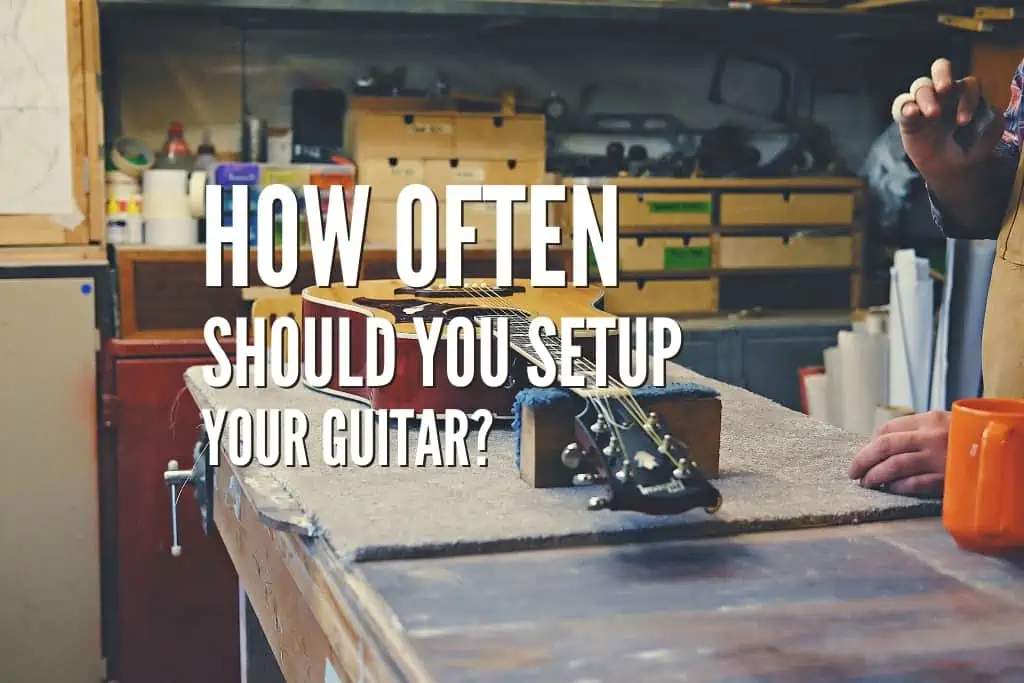Taking care of your guitar is essential to keep it in good condition. Setup is a crucial part of guitar maintenance and is required for your instrument to feel and sound great.
Most people who play guitar every day should be getting their instrument set up twice a year. However, it depends on many factors, such as temperature, humidity, or how often you play and change your strings. Others should be getting their guitars set up annually.
A regular setup keeps the instrument in the best state it can be, so it will be easier and more comfortable to play it, and it will also have the correct sound. Therefore, it is good to address the issue on time. Playing a fresh setup guitar helps you create music with comfort and confidence.
Do Electric/Acoustic Guitars Need To Be Set Up?
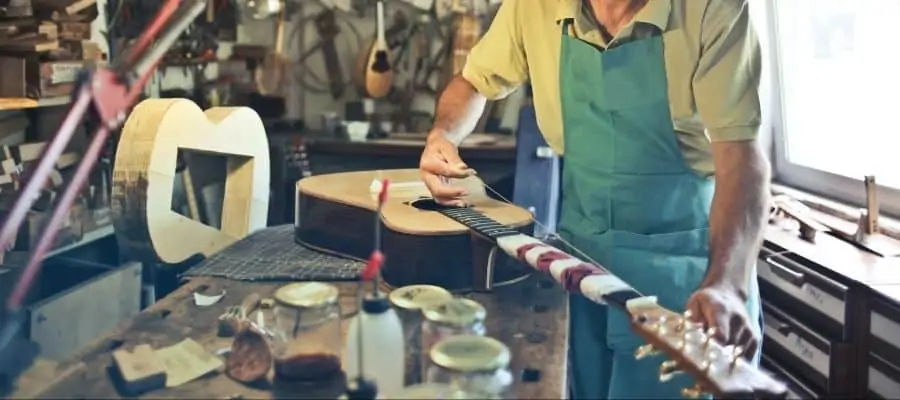
Every guitar can be affected by various factors that negatively impact its playability and accuracy. One of the reasons is that guitars are mainly wooden, and the wood is susceptible to humidity or temperature changes.
Guitars need regular upkeep to maintain a good condition. Otherwise, these changes can be harmful and cause more significant issues you won’t be able to fix.
Therefore, it doesn’t matter whether you are an electric guitar or acoustic guitar player – you should be getting your instrument set up.
It will make your guitar sound better because of the optimized sustain and intonation. Also, setup is essential to keep your instrument’s playability at a high level.
How Often Does Your Acoustic/Electric Guitar Need A Setup?

You need to take care of your guitar if you want it to sound and feel great. A regular setup keeps the instrument in good condition and doesn’t allow issues to accumulate and cause serious problems.
How often you practice, the intensity of playing, and seasonal changes are one of the many factors that determine how often your instrument needs a setup.
Acoustic guitars are pretty delicate – even small changes can affect the sound and playability. It’s because they are wooden, and the wood is highly sensitive.
Everything that affects steel-stringed instruments affects the nylon-stringed too. Therefore, everything applied to acoustic guitars can be applied to classical guitars as well.
Electric guitars rely on electrical hardware, but they have wooden construction. So, most requirements about setting up apply to this guitar type and bass also, as they feature similar construction and electric components.
It would be best to set up your guitar twice a year if you are a player who practices daily. If you don’t practice regularly, then setting up your guitar annually is enough.
If you haven’t played your guitar for a long time, it also needs a setup before the next use – an idle guitar is also affected by various factors that make small changes to it over time.
Your travel guitar is exposed to constant temperature and humidity changes, so that it may need a setup more often.
Of course, if your tuning keeps slipping or you have just noticed some electrical faults, it’s time for a setup, even though six months from the last setup haven’t passed yet.
How Do I Know If My Guitar Needs A Setup?
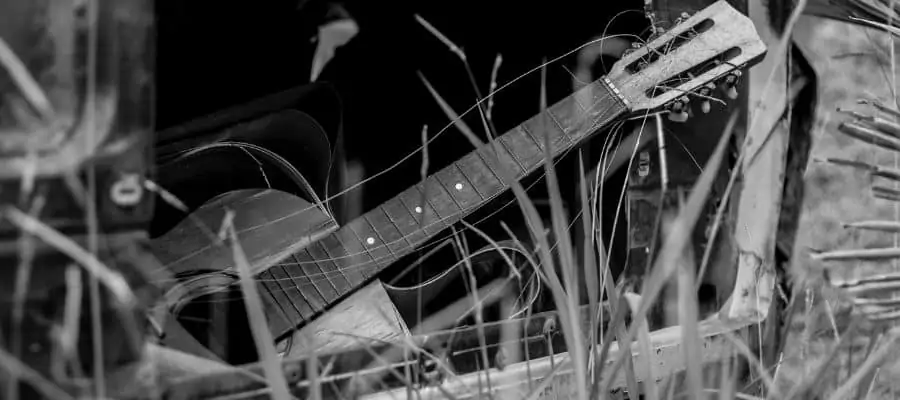
Guitars are primarily wooden, making them delicate to damage from humidity, temperature, playing, string tension, and so on. It all causes sound and playability changes.
It is recommended to set up your guitar twice a year to keep it in good condition. However, there is a chance that your guitar needs a setup a bit sooner or later.
First, ask yourself if your instrument is comfortable to play and if it is producing some rattle you’re unfamiliar with. If the answers are yes, then your guitar probably needs a setup.
There are various signs your guitar needs a setup. It’s important for you to detect them so you can set up your guitar and give new life to it.
Tuning Keeps Slipping
If your guitar sounds out of tune right after tuning, then it probably needs a setup. This problem bothers guitarists and disables them from sounding accurate while practicing or being on a stage.
It’s a serious problem, and it needs an immediate solution. There are some possible causes, such as nut issues or warped neck due to inadequate guitar storage, for example.
Intonation
Intonation is a guitar’s pitch accuracy up and down the neck. Play harmonic at the 12th fret and then fret a note. If the note you play after harmonics sounds flatter or shaper compared to the harmonic, that means your guitar intonation is set up badly.
The usual cause is the distance between the nut and saddle. You can try to repair it at your place. If the note sounds flatter it means that the string is too long. It shows that you need to move the saddle to the bridge side with an Allen wrench or screwdriver depending on your instrument.
If the note is slightly sharper it indicates that the string is slightly too short. So, you will need to move the saddles in the direction of the neck.
If the difference is still there and you can not manage to correct the intonation, it is time to call a doctor which means going to a guitar tech.
Action
The first thing that is recommended to check before going to the luthier for a setup is the string action. The action of a guitar must be consistent all through the neck. It is a matter of personal preference to have high, medium, or low action, but consistency is a must.
Issues with guitar action affect the playability of your instrument, and you can even deal with that annoying fret buzz while playing.
Three things determine the action – neck relief, the height of the nut, and the saddle height.
You can check relief by following some steps. Put a capo on the first fret, and depress the high E string at the 13th fret. Focus on the 7th fret and string action. The expected distance between the string and the fretboard is approximately a quarter of a millimeter.
If the string is touching the fret, then your neck needs more relief. If it’s far away from the fret, you’ll need to tighten the truss rod.
By depressing the string at the 3rd fret, you should get about the same measurement of approximately 0.25 millimeters from the top of the first fret to the underside of the string.
If the string is touching the fret, the nut is too low. If it’s far away from the fret, the nut is too high. That’s how you will estimate if the nut height is okay or not.
The final thing you need to check is the height of the saddle. It is done by measuring at the neck-body joint (where the guitar body meets the fretboard) with a wide enough ruler to touch both frets.
The expected bass string height is about 1/64, and the treble string height is about 3/32. Remember that measurements vary, and some shops can use other reference values.
If you assume that neck relief and the nut and the saddle heights are inadequate, then call the luthier and schedule a guitar setup.
Electronics
Check the guitar’s electronics if you hear anything strange while playing your guitar. If there is some kind of a rattle that is unknown to you, your guitar maybe struggles with some electronic issues.
Maybe the cause is a build-up of dust inside these components, which is fixable. If you did everything you could and the issue is still there, your guitar needs a visit at the luthier’s unless you know how to replace some components.
Dry Fretboard
If your fretboard feels and looks dry, it’s time for a setup. It can lead to neck bowing, warping, and even cracking. Having a hydrated fretboard is essential if you want your guitar’s neck to be strong.
Color change or white lines can indicate that your fretboard needs a drink and a setup.
Do New Guitars Need To Be Set Up?
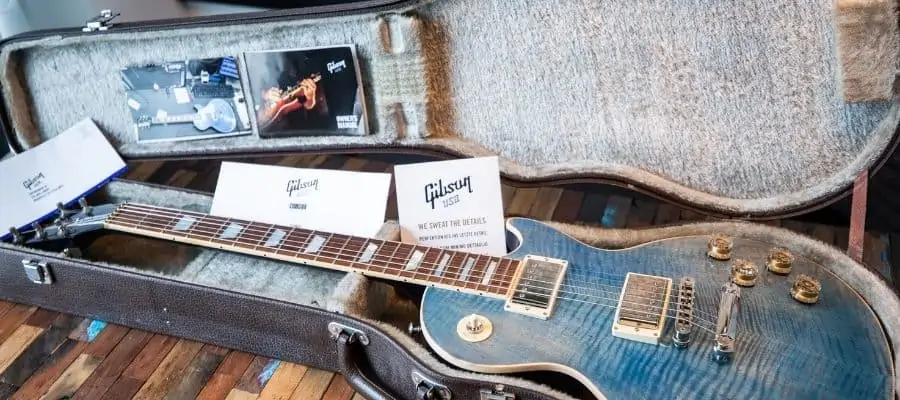
Many manufacturers have high-quality control standards, and they put all the effort into quality, details, and adjustments. They only approve flawless guitars to leave the factory.
On the other side, some reduce quality-control time and sell the instrument for a lower price. These instruments don’t have a decent adjustment, and they need a setup.
However, no matter if the guitar has a flawless setup or not, there is another problem – shipping. Guitars are shipped in containers, and temperature and humidity fluctuations significantly impact them. It can affect the guitar’s playability and sound.
Therefore, a new guitar does need to be set up if you want it to have the best possible sound and playability.
What Does A Guitar Setup Include?
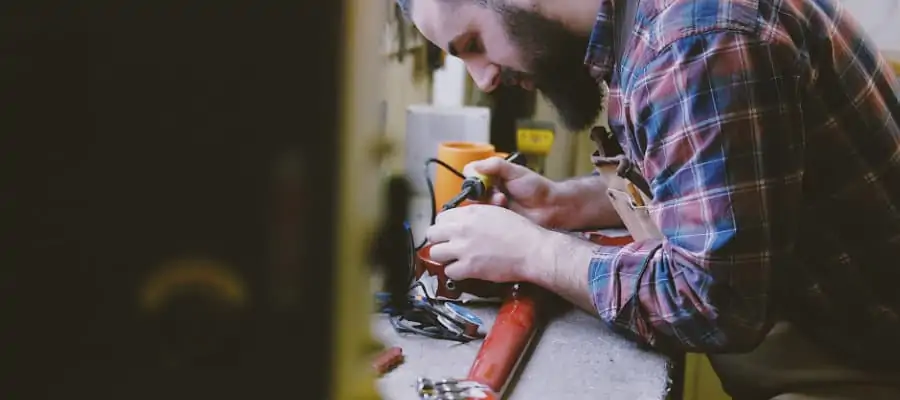
There is a standard task list for a guitar setup. Guitars that are rarely serviced usually require more work than a regular-maintained guitar.
Also, the electric-guitar setup is a bit different than the one for acoustic or classical guitar. Therefore, a guitar setup varies from guitar to guitar.
The main parts of the setup are inspection, action and intonation, electronics check, and clean-and-hydrate.
Inspection
The first step is a visual and mechanical check – a guitar tech has to look over your entire instrument to detect some issues and see what adjustments your instrument needs.
By inspection, a guitar tech can detect white lines or color changes on the fretboard, corrosion, hardware issues, neck issues, missing screws, etc.
Some guitar techs take notes – it’s like your guitar’s health record. It is helpful as a reference for subsequent setups. Action & Intonation
Action & Intonation
The action on your guitar is how high the strings are sitting above guitar frets. If the guitar action is too high, you are more likely to avoid fret buzz, but the instrument is way harder to play, especially for beginners.
On the other side, a low guitar action means better playability, but your instrument is more likely to produce that annoying fret buzz.
Guitar action is an individual thing – you choose what suits you the best. But, if it’s too low or high, your guitar definitely needs some changes.
Guitar action is determined by neck relief, the nut’s height, and the saddle. By adjusting these three, your guitar tech will set your desired action.
When it comes to intonation, your guitar tech will make it perfect by comparing the string’s sounds on the 12th fret. Fretted and the harmonic note should sound the same. If not, he/she will adjust the saddle and fix the intonation problem.
Electronics Check
It’s good to check your guitar’s electronics from time to time. Dust and dirt can get into your instrument and cause problems. So, it’s recommended to clean it regularly. Your guitar tech can detect if it’s time for a specific component replacement.
Floating Bridge And Tremolo Adjustment
The bridge tension on the guitar must be balanced for the bridge to be in a proper position for playing. While the string tension pulls the bridge up, the claw position and springs pull the bridge down.
There are different ways to achieve balance such as adding or removing springs, moving the claw springs, or replacing them with new springs with less or more tension strength.
Pickup Height
To get the desired tone and volume, it’s important to adjust the pickup height. Pickup height affects those two, and it’s dependent on the final height of the strings.
Clean-And-Hydrate
The fretboard is the guitar part where your hands are constantly present while playing. Therefore, it needs to be perfectly treated.
A clean and hydrated fretboard means a strong neck. It is vital for a guitar neck to be strong because it deals with string tension. Not taking care of your fretboard can lead to more significant issues, such as neck warp, bow, and crack.
Set up includes a fretboard treatment with fret protectors, lemon oil, and polishing creams. It will improve the playability of your instrument.
Can I Do My Own Guitar Setup?
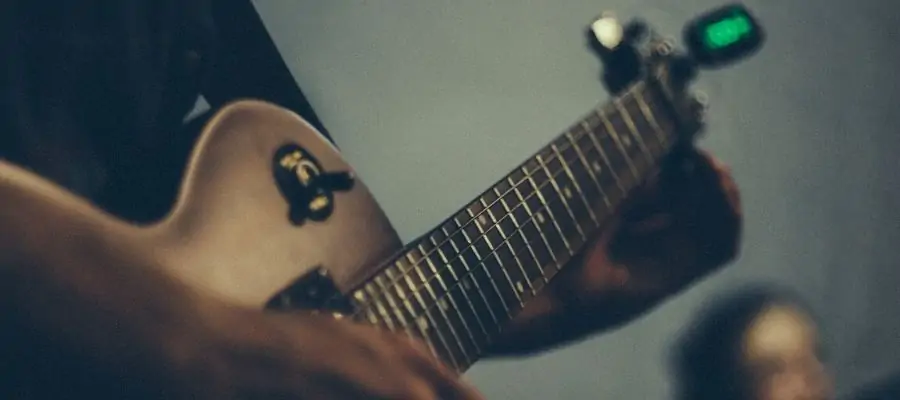
If you learn setup tasks correctly, you can set your guitar up at your place. The tools required for the whole process are not that expensive, and they will pay off soon.
If you have the will, patience, and time to learn, go for it. You can watch some YouTube videos and tutorials on setting up your guitar. Also, read other people’s advice and experiences on forums and social media.
But, I recommend you visit your guitar tech, especially if you are a beginner. That’s how you can be sure all of the major adjustments are made.
From there, you can learn some basic adjustments on your own, such as adjusting the intonation and guitar action. Also, if you can afford it, it would be great if you had one guitar to learn on. You don’t want to destroy your favorite Les Paul, don’t you?
What Is The Correct Order To Do A Setup?
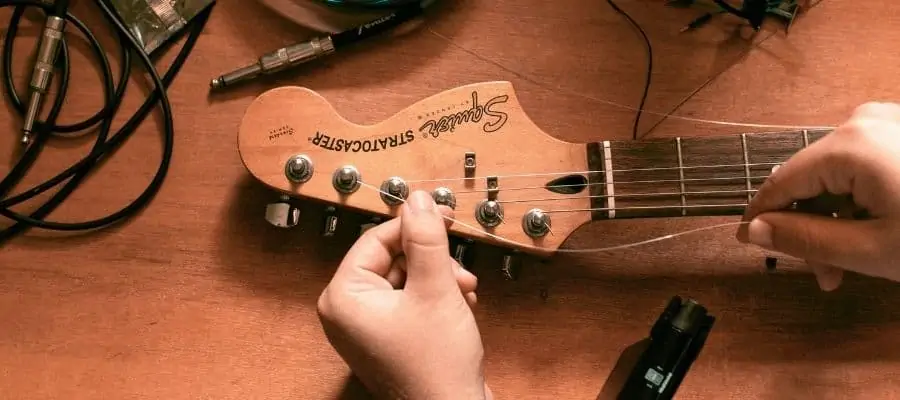
If you want the guitar setup to be effective and make your instrument sound and feel perfect, you need to follow the specified order of steps.
There is a good reason for it – one thing is dependent on the other being right first. It is nonsense to do nut filing before you knew the neck relief was okay.
First, you need to do an inspection and take care of the neck relief. Setting action, pickup height, or nut is pointless until you adjust the neck relief.
Then, do a tremolo balance and then set the action for all strings. If you adjust the action before it, then the action will change with a tremolo-balance step.
After that, work on the nut and pickup height. It’s pointless to adjust pickup height sooner – it’s dependent on the action of the strings.
The next step is a hardware check, cleaning electronics from dust, and replacing some components if needed.
Intonation depends on pretty much every step above, so you need to save it for the end, as well as clean and hydrate the fretboard.
How Much Does A Full Guitar Setup Cost In The US?
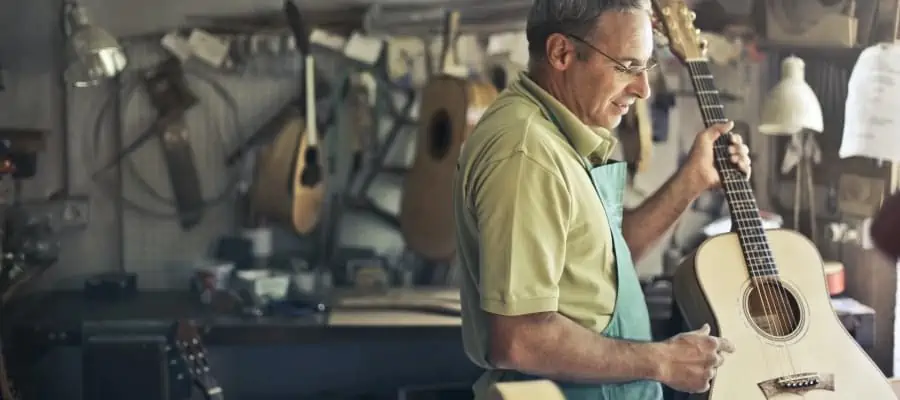
The guitar setup price varies, depending on where you live, in what condition your guitar is, your guitar type, the shop, and additional parts that may be needed.
If your guitar were regularly maintained, then you would probably be dealing with less serious issues.
On the other side, if your instrument is in bad condition, a guitar tech will need to work more on it, which affects the price.
If you take your guitar to smaller, local companies, they will charge less than larger corporate music shops.
Also, you need to pay slightly more for an electric guitar setup than for an acoustic or classical one because it has more components that need addressing.
If you own a 7, 8, or 12-string guitar, be ready to add roughly $40 to the price for a 6-string guitar.
How Long Does It Take To Get Your Guitar Set Up?
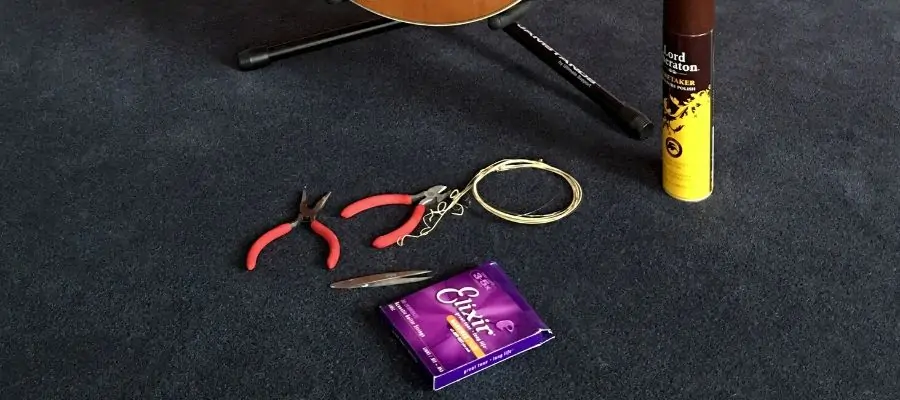
The period needed for a guitar tech to set up your guitar varies, depending on how many issues he/she needs to fix.
Also, how long you have to wait for your guitar depends on the person’s popularity doing the work and a function of the person’s speed.
Most techs do the job in a day; some need more days because they are in a rush or need to do more serious work on your guitar, such as replacing some guitar parts.
Therefore, finding a smaller company with a smaller customer base may lead you to have a quicker and more hassle-free service. You can also get a faster delivery from the larger music stores for an additional fee.
Conclusion
Setting up your guitar keeps it in the best state it can be, so it will be easier and more comfortable to play it, and it will have the correct sound as well. Playing a fresh setup guitar helps you create music with comfort and confidence.
It would be best to set up your guitar twice a year if you are a player who practices daily. If you don’t practice regularly, then setting up your guitar annually is enough.
It doesn’t matter what guitar type you own – every guitar needs a setup—even the new one.
If you found this article useful, you may want to save this pin below to your Guitar board.

Recent Posts
Some guitarists insist on buying an expensive amplifier with their electric guitar. They assume that this is a must for every type of guitarist out there. However, in some situations, this isn’t...
Top 50 Free Realistic Guitar VST Plugins With Sound Examples
As technology has rapidly advanced in the recent decade, computers are stealing more and more roles from physical musical instruments and accessories. Nowadays, you do not need expensive amps,...

